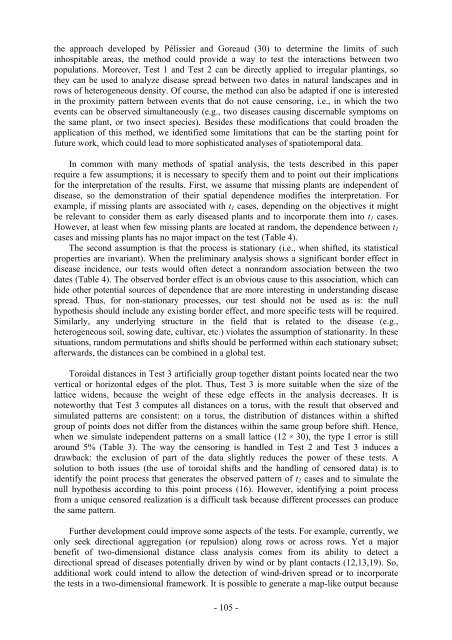Ecole Nationale Supérieure Agronomique de Montpellier ... - CIAM
Ecole Nationale Supérieure Agronomique de Montpellier ... - CIAM
Ecole Nationale Supérieure Agronomique de Montpellier ... - CIAM
You also want an ePaper? Increase the reach of your titles
YUMPU automatically turns print PDFs into web optimized ePapers that Google loves.
the approach <strong>de</strong>veloped by Pélissier and Goreaud (30) to <strong>de</strong>termine the limits of such<br />
inhospitable areas, the method could provi<strong>de</strong> a way to test the interactions between two<br />
populations. Moreover, Test 1 and Test 2 can be directly applied to irregular plantings, so<br />
they can be used to analyze disease spread between two dates in natural landscapes and in<br />
rows of heterogeneous <strong>de</strong>nsity. Of course, the method can also be adapted if one is interested<br />
in the proximity pattern between events that do not cause censoring, i.e., in which the two<br />
events can be observed simultaneously (e.g., two diseases causing discernable symptoms on<br />
the same plant, or two insect species). Besi<strong>de</strong>s these modifications that could broa<strong>de</strong>n the<br />
application of this method, we i<strong>de</strong>ntified some limitations that can be the starting point for<br />
future work, which could lead to more sophisticated analyses of spatiotemporal data.<br />
In common with many methods of spatial analysis, the tests <strong>de</strong>scribed in this paper<br />
require a few assumptions; it is necessary to specify them and to point out their implications<br />
for the interpretation of the results. First, we assume that missing plants are in<strong>de</strong>pen<strong>de</strong>nt of<br />
disease, so the <strong>de</strong>monstration of their spatial <strong>de</strong>pen<strong>de</strong>nce modifies the interpretation. For<br />
example, if missing plants are associated with t1 cases, <strong>de</strong>pending on the objectives it might<br />
be relevant to consi<strong>de</strong>r them as early diseased plants and to incorporate them into t1 cases.<br />
However, at least when few missing plants are located at random, the <strong>de</strong>pen<strong>de</strong>nce between t1<br />
cases and missing plants has no major impact on the test (Table 4).<br />
The second assumption is that the process is stationary (i.e., when shifted, its statistical<br />
properties are invariant). When the preliminary analysis shows a significant bor<strong>de</strong>r effect in<br />
disease inci<strong>de</strong>nce, our tests would often <strong>de</strong>tect a nonrandom association between the two<br />
dates (Table 4). The observed bor<strong>de</strong>r effect is an obvious cause to this association, which can<br />
hi<strong>de</strong> other potential sources of <strong>de</strong>pen<strong>de</strong>nce that are more interesting in un<strong>de</strong>rstanding disease<br />
spread. Thus, for non-stationary processes, our test should not be used as is: the null<br />
hypothesis should inclu<strong>de</strong> any existing bor<strong>de</strong>r effect, and more specific tests will be required.<br />
Similarly, any un<strong>de</strong>rlying structure in the field that is related to the disease (e.g.,<br />
heterogeneous soil, sowing date, cultivar, etc.) violates the assumption of stationarity. In these<br />
situations, random permutations and shifts should be performed within each stationary subset;<br />
afterwards, the distances can be combined in a global test.<br />
Toroidal distances in Test 3 artificially group together distant points located near the two<br />
vertical or horizontal edges of the plot. Thus, Test 3 is more suitable when the size of the<br />
lattice wi<strong>de</strong>ns, because the weight of these edge effects in the analysis <strong>de</strong>creases. It is<br />
noteworthy that Test 3 computes all distances on a torus, with the result that observed and<br />
simulated patterns are consistent: on a torus, the distribution of distances within a shifted<br />
group of points does not differ from the distances within the same group before shift. Hence,<br />
when we simulate in<strong>de</strong>pen<strong>de</strong>nt patterns on a small lattice (12 × 30), the type I error is still<br />
around 5% (Table 3). The way the censoring is handled in Test 2 and Test 3 induces a<br />
drawback: the exclusion of part of the data slightly reduces the power of these tests. A<br />
solution to both issues (the use of toroidal shifts and the handling of censored data) is to<br />
i<strong>de</strong>ntify the point process that generates the observed pattern of t2 cases and to simulate the<br />
null hypothesis according to this point process (16). However, i<strong>de</strong>ntifying a point process<br />
from a unique censored realization is a difficult task because different processes can produce<br />
the same pattern.<br />
Further <strong>de</strong>velopment could improve some aspects of the tests. For example, currently, we<br />
only seek directional aggregation (or repulsion) along rows or across rows. Yet a major<br />
benefit of two-dimensional distance class analysis comes from its ability to <strong>de</strong>tect a<br />
directional spread of diseases potentially driven by wind or by plant contacts (12,13,19). So,<br />
additional work could intend to allow the <strong>de</strong>tection of wind-driven spread or to incorporate<br />
the tests in a two-dimensional framework. It is possible to generate a map-like output because<br />
- 105 -



